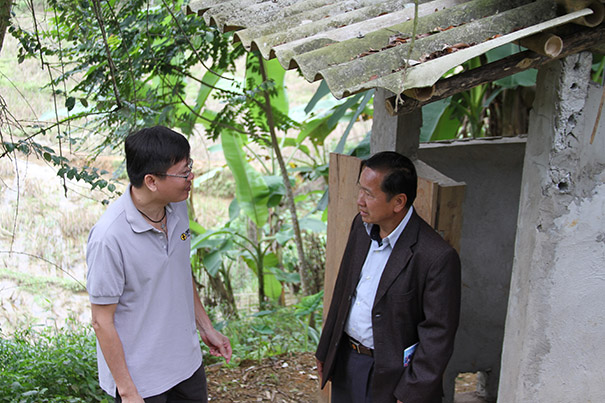Stories of Change

Vi Ngoc Tu (right) talks to CWS's Vietnam Country Representative in front of his family's latrine. Photo: Andrew Gifford / CWS
20 million people in Vietnam do not have access to improved sanitation.
Building latrines, ending open defecation in Vietnam
Latrines.
If you always have access to a toilet, you may not think it’s a big deal. For the 35 percent of the world’s people who don’t have indoor toilets or outdoor latrines, though, it’s a huge deal.
This is certainly true in Vietnam, where 20 million people do not have access to sanitary latrines. Of those, six million don’t have any kind of latrine and have to use fields or streams as toilets. That means that the number of people just in Vietnam who don’t have sanitary latrines is roughly equal to the combined populations of New York City, Los Angeles, Chicago, Houston and Philadelphia, the largest five cities in the United States. All these people. Without toilets. Every day.
Vietnam’s ethnic minority communities – which are generally poorer than others in the country and are often culturally or geographically isolated – are less likely than others to have any kind of latrines. In these communities, nearly one person in three doesn’t use a toilet or latrine, and there are a variety of different reasons for this. Even if families understand the harm of open defecation and want to build latrines, poverty often stops them. Other priorities, like food and fuel, take precedence.
CWS has been working with communities in Vietnam for more than 60 years and, for our team today, the problem of open defecation is one we work seriously to address. Without safe, sanitary latrines, it’s really easy for human waste to end up in people’s food and water.
Let’s think this through.
If you use a field as a toilet, your waste is out in the open where flies and other insects can get to it and then transmit harmful germs to you, your food or your family. If you decide to use a stream instead, you’ve introduced human waste directly into a water source that is used for bathing, for watering vegetables and, often, for drinking.
Either way, that waste is still reaching people directly.
Clearly, ingesting human waste residue is harmful and the resulting illness can lead to people having to take time off work to recover or even needing to spend time and money to visit a clinic and, maybe, take medicine. Across Vietnam, because of open defecation alone, avoidable illnesses have a major economic impact. Each year, it is estimated that Vietnam loses $780 million in worker productivity and needless healthcare spending as a result of the persistence of open defecation.
This is why getting people to use safe, sanitary latrines is a top priority for CWS in Vietnam. Our approach is called Community-Led Total Sanitation, or CLTS. Through this model, CWS provides technical assistance to community leaders on how to build and properly use sanitary latrines, and our team also shares information about the health impacts and associated costs of open defecation. We also share stories and best practices learned from other communities with which we have partnered. Community leaders then return to their villages to share what they have learned and to motivate their friends and neighbors to build latrines.
Once a village is interested in investing in latrines, a CWS technician works with them to build a first latrine so everyone can know how a latrine is properly built and how it works. Then families can build latrines on their own, choosing from a number of different designs. Families also then have the skills to repair latrines when needed.
The CLTS model has paid off. This past year, CWS helped build more than 1,300 latrines in Vietnam, with 17 villages being certified as Open Defecation Free as a result, including one commune made up of 13 villages.
Ultimately, in a single year, more than 7,000 people have sanitary latrines with the help of CWS.
One of the villages that participated in CLTS this year is Poc, which is in Thanh Hoa province, about a five hour drive southeast of Hanoi.
Vi Ngoc Tu, the village leader and a member of Vietnam’s Thai ethnic minority, attended a CLTS training workshop in June in a town about an hour from the village, where he joined leaders from other villages as well as a representative from the district health center. Among other things, Mr. Tu came to understand, once he took the time to think about it seriously, how open defecation can ultimately lead to people ingesting human waste. He decided to take action for his village.
After the workshop, Mr. Tu became one of five community members who helped mobilize and motivate each of the 53 families in the villages to build sanitary latrines for the sake of their own and the whole community’s health. It took a few weeks to visit every family and rally support, but in August the first latrine was built in Poc.
In just four months, the community built 53 latrines – one for each family. Most are dry latrines with two chambers. Leftover kitchen ash is sprinkled into the chamber after each use to speed up waste fermentation. When one chamber is full, it is sealed off for six months. After that time, the waste has fermented and can be used for organic fertilizer. It is no longer dangerous if consumed.
Today, the people of Poc say that since they built their latrines, no one from the village has had to go to the hospital or clinic because of diarrhea or related issues.
Besides reducing common health risks, like diarrhea, using sanitary latrines is known to reduce poverty. Healthy adults can work, and families can save the money that would have had to be spent on medicine and clinic visits. Together, we can support communities in Vietnam and around the world as they improve their sanitation.
